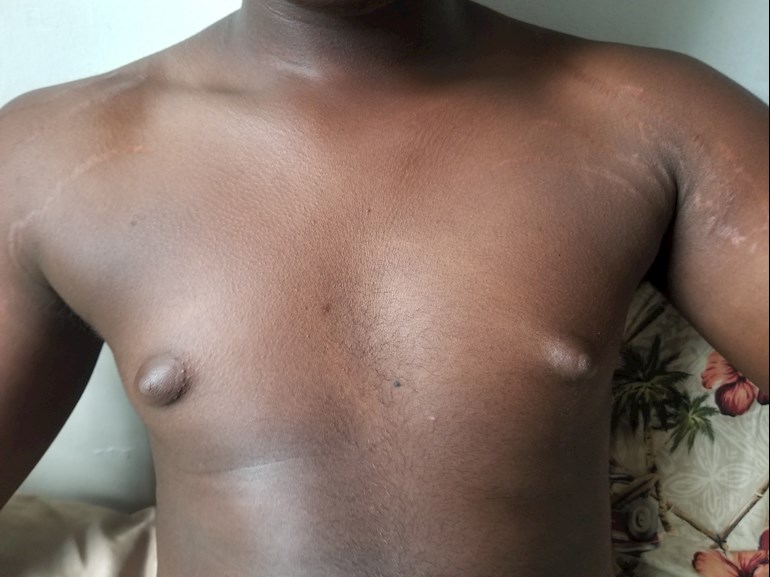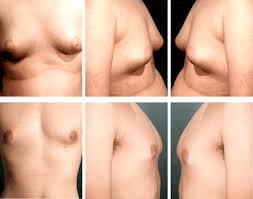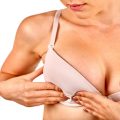Some men might experience inflamed or puffy nipples. Several factors can lead to puffy nipples in men, including hormonal imbalances, certain exercises, and excess body fat. Although they can be uncomfortable, puffy nipples rarely indicate a medical emergency.
In most cases, making dietary and exercise-related changes will help. However, if making these changes do not help, surgery may be necessary to reduce swelling and return the nipples to their previous state. In this article, we examine the causes of puffy nipples in men.
Gynecomastia is one of the most common reasons for puffy nipples in men. In the condition, a man experiences the growth of glandular tissue in their breast. The growth of glandular tissue in breasts leads to abnormal breast development in men. This condition is most common in teenage boys and older men. Men with gynecomastia have a disc or button-like growth in the nipples that can be felt and sometimes is visible. The growth of tissue differs from men to men; it can be bilateral or unilateral and symmetrical or asymmetrical. It’s not always important that the puffy nipples occur due to gynecomastia. There can be some other reasons also. Following is the list of more reasons for puffy nipples in men.
Causes
Some causes of puffy nipples in men include hormonal imbalances, steroid use, and certain exercises. Some possible causes of inflamed or puffy nipples in men include:
Hormonal imbalances: Hormonal imbalances occur when there is too much or too little of a hormone in the bloodstream. Because of their essential role in the body, even small hormonal imbalances can cause side effects throughout the body. Hormones are chemicals that are produced by glands in the endocrine system.
Steroid use: Steroids (sometimes referred to as “roids” or “juice”) are the same as, or similar to, certain hormones in the body. The body makes steroids naturally to support such functions as fighting stress and promoting growth and development. But some people use steroid pills, gels, creams, or injections because they think steroids can improve their sports performance or the way they look. They can affect various parts of your body including the nipples of men.
Certain exercises: Some exercise have been proven to cause both puffy nipples and bigger breasts. Exercises that focus on the pectorals, back, and shoulder muscles can help to firm and tone the chest muscles behind your breast tissue and improve your posture. Developing the muscles underneath your chest will enhance the look of your breasts and make your nipple appear larger. In addition, the repetitive motion of running can cause friction between the skin of the nipple and the fabric of the clothing, which can lead to chafing, otherwise known as “jogger’s nipple.”
Having excess body fat: When a man develops excess fat tissue in the breasts, it can make the nipples appear larger than usual. Being overweight can also cause hormonal imbalances in men. In one 2017 study, researchers found that men with more body fat showed lower levels of testosterone and higher levels of estrogen.

How to Get Rid of Man Boobs and Puffy Nipples
Here are some tips that you should follow, so you can now say goodbye to those unwanted man boobs and dome-shaped nipples.
Exercise – doing exercise helps you to lose fat, and that includes the excess fats in your breasts.
Wear Compression Shirts – Compression tops are known to reduce man boobs. It looks like a regular t-shirt, but it acts like a girdle.
Avoid Eating Foods That Are High In Estrogen – estrogen is the hormone that is responsible for sexual and reproductive development. Eating high-estrogen food such as soybeans, tofu, flaxseeds, and many more contributes to having large breasts. So, you might want to avoid that. Try eating foods that are low in calories and rich in nutrients to prevent having man boobs.
Liposuction – a cosmetic surgery wherein only your breast fats will be removed, but not your breast tissue.
Mastectomy – an invasive surgery used to remove your breast gland tissue. It is usually used for people who have severe gynecomastia. Mastectomy usually takes about four weeks to recover. Because the subject of gynecomastia can be a bit uncomfortable for many, there is a fair amount of misinformation about it. There are myths about what causes the condition and the ways to treat it.
Myth and Facts about gynecomastia and puffy nipples
Myth: It’s Only Caused by Excess Fat
One common myth about gynecomastia is that only very overweight men develop it. A man who’s at a healthy weight might assume that he is in the clear because he doesn’t have a lot of extra fat. While there are cases where excess fat can make a man’s breasts look larger, fat alone isn’t the cause of the condition. Gynecomastia occurs when a male develops actual breast tissue, not just a bit of fat in the chest area.
Fact: Hormones Play a Part
What’s really behind gynecomastia is an imbalance of hormones. A man is more likely to develop breast tissue when the amount of testosterone in his body decreases and the amount of estrogen increases. Although associated with female characteristics, all males have a small amount of estrogen in their bodies. When estrogen levels rise, problems can develop, such as male breast tissue.
Myth and Fact: You’ll Develop Breasts if You…
The big question might be: what can cause a man’s estrogen levels to rise? The answer is a number of things. There’s also a lot of misinformation about what can lead to a significant increase in estrogen or a significant hormone imbalance.
For example, alcohol consumption is often connected to gynecomastia. But, not necessarily in the ways people think. IPAs or beers with high levels of hops are sometimes blamed for causing the condition or there’s a scare that drinking a lot of IPAs will trigger the development of breasts. Hops do contain a type of phytoestrogen, or a type of estrogen found in plants. Overall, the levels of phytoestrogen found in IPAs or other types of hoppy beer aren’t high enough to create a hormonal imbalance in men.
But, there can be an issue when it comes to alcohol consumption. A man who drinks a lot can be causing damage to his liver. Liver damage can interfere with the organ’s ability to convert hormones from one form to another, leading to the development of breast tissue.
Certain prescription medications can also cause gynecomastia, such as medicines taken for an enlarged prostate, as well as anti-depressants, some antibiotics, and heart medications. Endocrine problems in a man can also lead to the development of breast tissue, such as an overactive thyroid or an underactive pituitary gland. Some herbal treatments, such as the use of lavender oil, might increase a man’s chance of developing gynecomastia.
Myth: You Can Exercise the Breasts Away
In some cases, gynecomastia will resolve on its own, as soon as the hormonal imbalance is corrected. There’s a misconception that increasing the amount you exercise or that performing exercises that focus on toning the chest will help the issue. That might be true if the enlarged breasts are due to extra fat tissue only. But, since gynecomastia is the development of breast tissue, there is no way to burn off the extra tissue. Even if the enlarged breasts were only thanks to fat, there’s no real way to “spot train” the body, meaning that you can’t perform a series of exercises and expect to see a significant reduction in fat in one part of the body only.
Fact: Surgery Can Be a Good Option
Surgery can be a reliable treatment option for men with gynecomastia that doesn’t resolve itself when a hormone imbalance is corrected or when medications related to the condition are adjusted. There are a few options for surgery, depending on the severity of the condition.
A man with limited breast tissue but a considerable amount of extra fat in the chest area will most likely benefit the most from liposuction. If there is a considerable amount of breast tissue and fat, the surgeon will most likely perform liposuction to remove the fat and excise or cut away, the breast tissue, through an incision made near the armpit or nipple.
The most severe cases of gynecomastia require a more complicated surgery, which usually combines liposuction, excision of the breast tissue, and a breast lift to remove any excess, loose skin. More severe cases typically require a procedure that is similar to that of a breast reduction in female patients.






